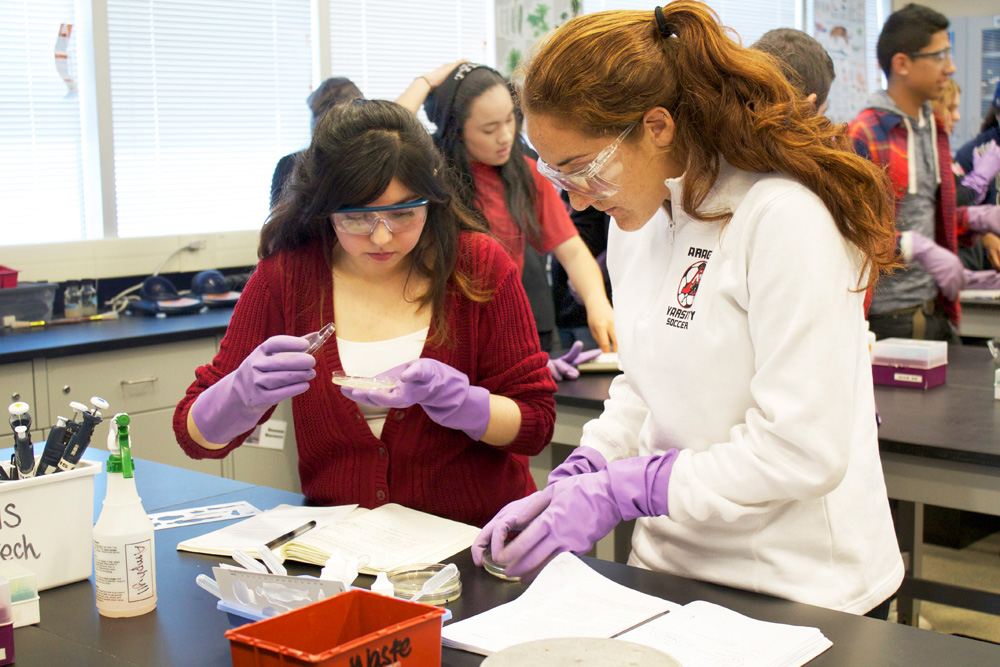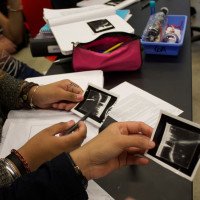
Seniors Candy Beltran and Jordan Lewis prepare samples in an agarose gel for a lab in Biotechnology 1-2.
AP Physics B Splits
Starting next year, AP Physics B will no longer be offered in its current form. Instead, it will be split into two year-long courses: AP Physics P1 and AP Physics P2. This change reflects College Board’s decision to split AP Physics B after concluding that students did not have an in-depth understanding of the material when it was taught in one year.
Students are discouraged from taking P1 and P2 concurrently, given that much of the information learned in P1 is needed to be successful in P2. If enough students sign-up, there will also be a new AP Physics C class, which uses calculus in the study of mechanics and electricity and magnetism. AP Physics C has failed in the past to become a class at Aragon due to a lack of students agreeing to take the course.
“Right now, AP Physics is very fast,” says science teacher Steve Ratto. “AP Physics P1 is going to be a little slower than that … It’s still going to be difficult, but it’s going to have [fewer] topics so we don’t have to move as fast.”
Current AP Physics B student and sophomore Jonathan Liu supports the change, saying, “[AP Physics B] is a bit fast, especially the work from the second semester … [Splitting the class] lets the concepts sink in without the stress of covering everything by AP testing. Sometimes in our class, it seems like we’re memorizing equations rather than actually learning about the physics.”
For students enrolling in their first year of a physics course, placement into Physics 1-2 or AP Physics P1 depends on their math level. Students going into Physics 1-2 must have completed Geometry, whereas students going into AP Physics P1 must have completed Algebra 3-4. If students decide to take a second year of physics, they can then choose to take either AP Physics P2 or AP Physics C.
AP Physics P1 will cover the topics of mechanics, waves and sound, circuits, and energy, whereas AP Physics P2 will cover fluids, thermodynamics, electricity and magnetism, optics, and atomic and nuclear physics.
Ratto states that many schools are not offering AP Physics 2.
“AP 2 is not going to be as helpful for kids as AP Physics C,” says Ratto. “So if you take AP Physics 1 or regular physics, you’ll have enough of the background to be able to realize, ‘Okay, this is something I’m interested in, I should be going to the calculus level.’”
He suggests, “If you were going to go into [anything related to science and math] in college, you should take AP Physics C.”
It has not yet been decided who will teach these additional physics classes, but Ratto says, “If it is possible, I would like to teach all of them.”
Biotechnology 3-4
Another class added to the Aragon course list is Biotechnology 3-4. The administration has been discussing this addition for some time.
Current Biotech 1-2 and AP Biology teacher Katherine Ward says, “When Biotech 1-2 was brought to Aragon, the plan always included eventually expanding the program to a two-year sequence. And when the new building was completed, we really [needed] to expand to take full advantage of the facilities we have to the benefit of our students.”
Students interested in taking Biotech 3-4 will first need to complete Biotech 1-2, as proficiency in basic lab skills will be expected at the beginning of the year. Biotech 3-4 will introduce students to more advanced biotechnology techniques and focus on agricultural, environmental, and diagnostic biotechnology.
“Biotech 3-4 is an applications—let’s apply the information to real problems and real questions—course, whereas Biotech 1-2 is a methods course,” says Ward.
Current Biotech 1-2 student and sophomore Dhruv Rohatgi is excited about the implementation of Biotech 3-4. “I believe that the addition of Biotech 3-4 this year is great,” he says.
“[And] I do plan on taking [it]. It will be very different, and we will be working out in the field and can potentially be working alongside some local biotech companies.”
“[This course will] ask students to apply these techniques to long-term research projects and contribute data and analysis to nationwide studies—citizen science,” confirms Ward.
In preparation for this class, there will be additional professional development for teachers this summer, and a list is being made of all the materials necessary for the course.
Counselor Steve Allekotte says that the implementation of these new classes should not cause any conflicts, as long as at least 25 people sign up for each class. “I think it’s great to have more choices,” he says. “Our school is such that we offer classes that people want to take. We usually give kids what they ask for.”



